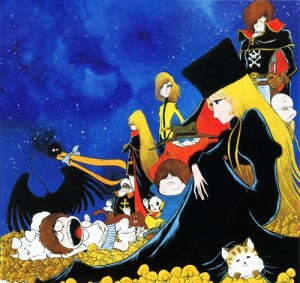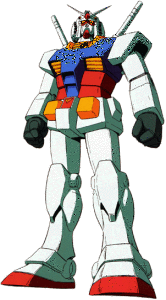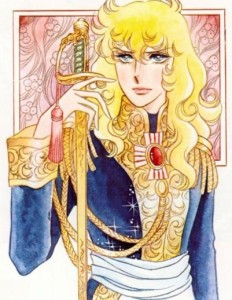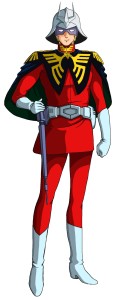An Anime Fan’s Wishlist: 1979 Edition
by RadiumEyes, HSM guest contributor
Ah, anime.
PlayStation Home recently received several costumes celebrating the 35th anniversary of both Captain Harlock and Galaxy Express 999, both iconic productions led by Matsumoto Leiji. This is big news for anime fans such as myself – classic characters get the Home treatment, opening the door for potential other licenses. The industry provides an overwhelming amount to choose from, and it’d be a Herculean task to wade through all the available shows to find a few choice suggestions. As a self-proclaimed anime nut and overall armchair commentator on anime, this would be right up my alley. Be forewarned, however – this article may get long-winded. I will likely betray my intense enjoyment of the medium, and subsequently my otakudom.
As a start, let’s look at some history. Japan’s animated output began very early on – an undated 5-second short, Katsudō Shashin, was hailed upon its discovery as being ten years older than the earliest anime to have a verified date (Nakamura Gatana, 1917). From there, anime picked up steam in the 1930s, with most of the animated shorts being adaptations of folklore and historical events (with Benkei and Hideyoshi Toyotomi receiving their own animated outings).
For the sake of brevity, I’ll fast-forward to the 1960s, where things really heat up for the anime market. Television, that wonderful little box of electrodes, allowed people to watch filmed content from their living rooms; the 1960s began with the first televised anime, an experimental short called Mittsu no Hanashi. From there, we can go to 1963, the Big Year; Tetsuwan Atom (localized Stateside as Astro Boy) and Tetsujin 28-go (localized as Gigantor) both debuted that year. That humble beginning got the ball rolling, and today, dozens of shows get release every year.
With the release of Captain Harlock and Galaxy Express costumes on Home, this rich history of anime can draw in funds. Before I get into the meat of this article, let me preface it with a bit of history.
Anime’s importance to the film industry is a special one – live-action films declined in the years that saw anime come to fruition, and anime helped bring it back. The 1960s saw the decline of the studio system in Japan, what with television’s popularity rising. Theater attendance dwindled pretty dramatically, and several studios (such as Shochiku and Toei) scaled back on film production. Something needed to be done to raise audience attendance, and fast. The answer came in the form of various films exhibiting violence and sex on a level not seen before; although these motifs existed in ukiyo-e prints prior to the late 18th century, the violence and sex seen here had a more immediate, sensationalist tone.
At this point, the presence of early notable figures in live-action film waned; Uzo Yasujiro died in 1963, Naruse Mikio’s release schedule was minimal during the decade (he died in 1969); Honda Ishirō still plied his trade in sci-fi movies (including 1963’s Matango and 1966’s War of the Gargantuas). The tokusatsu genre (which emphasized special effects) remained a draw, but Gojira movies of the decade pandered to a more juvenile audience than the 1954 original. Kurosawa Akira was still active (up until his death in 1998), but his output lessened significantly during the 1970s after a failed suicide attempt. Kurosawa’s films Sanjuro, Yojimbo and High and Low remain highly regarded, nonetheless.
The 1960s and 1970s were the decades of the “outlaw” filmmakers – Suzuki Seijun, Kobayashi Masaki, Yamada Yoji, Imamura Shōhei and many others, a trend that continues to this day (with directors such as Takashi Miike and “Beat” Takeshi Kitano helming the same approach to film). Films of these decades were violent and nihilistic, with yakuza, sexual encounters and strong female leads taking center stage; the theaters could advertise that they provided some form of visceral entertainment that could not be broadcast on television. The same timeframe provided the extremely popular Tora-san and Zatoichi series, featuring a gentle vagabond and blind swordsman, respectively.
During this tumultuous cinematic atmosphere (one can compare this trend to a similar one occurring at the same time in the United States – the New Hollywood movement), anime blossomed on television. The 1970s saw a surge in animated television series, and some of the greatest sci-fi anime ever produced debuted in the decade (Galaxy Express included). If you wanted giant robots fighting prehistoric monsters controlled by an evil empire, Mazinger Z had you covered. Ashita no Joe offered boxing fans a glimpse into the heady world of their favorite sport. The World Masterpiece Theater series offered adaptations of famous Western works, from Heidi of the Alps to Huckleberry Finn. They were some very good years for anime.
So how does this tangent involve Home, you may ask? It provides some context to animation history, and to get some perspective on how wide a range anime covers. Galaxy Express 999 and Captain Harlock are only two stars in a great sea of titles, and with famous names already offered, the future looks bright for more releases. I have my own wishlist in mind for anime I would love to see represented on Home, and I wish to include them here. Bear in mind that this comes from a professed fan of anime, and this stems from my experience with various shows.
First things first – let’s look at next year. Since this year had a 35th anniversary celebration of two great anime, the best start for an anime wishlist (for me, at least) would be for shows that would have their own 35th anniversary in 2014. In 1979, two phenomenally popular anime made their broadcast debuts: Rose of Versailles and Mobile Suit Gundam. The former requires a bit of introduction. Ikeda Riyoko, a member of the influential Year 24 group of mangaka, received enormous fame for her Rose of Versaille manga, a series based on the life of Marie Antoinette that ran from 1972 to 1973. This manga earned a place in history as the first successful shōjo work written by a woman; prior to this, girl-oriented works were scarce, and Marie Antoinette offered a complex character in a complex social situation that thrilled readers. It also offered the first “bed scene” in a manga, featuring Oscar (commander of the Versailles guard) and Andre Grandier (her close friend).
Such an influential and popular series should get its own costume line on Home. The obvious choices would be Andre, Marie Antoinette and Oscar, with Hans Axel von Fersen being a possible choice to make the male and female costumes even. As these characters (aside from Oscar and Andre) are based on real people, however, this one would likely require some caution. This is particularly true of Marie Antoinette, whose fall from grace and execution remains a topic of debate. Considering that, I would love to see this show make the transfer to Home.
As a note, this show recently got picked up for U.S. localization, a pretty long time as far as Western distribution of anime is concerned. Home-related content for Rose of Versaille would thus coincide with the show’s first localized appearance in the U.S., so celebrations all around.
And now for the second show mentioned: Mobile Suit Gundam. The iconic pilotable robots in this series are based on the shock armor from Starship Troopers, and it focuses on a year-long war between the Earth Federation and Zeon. This show was nearly cancelled due to low ratings; instead, its episode count got reduced from 52 to 39 (later increased to 42 after negotiations). However, the show’s popularity increased over the years, and this new interest led to the creation of more series; Gundam became a franchise, and model kits of the mobile suits featured in the various shows and OVAs are popular sells.
Japan already has seen its fair share of anime releases; in 2011, Japan’s Home server hosted a Macross event. For those of you unfamiliar with the title, Macross refers to a franchise that began in the 1980s, with transformable units known as Valkyries taking center stage. Fans of Robotech would recognize it as that series’ “first generation.” Neon Genesis Evangelion also received the Home treatment – in 2012, an Ayanami Rei (wearing what is known as a “plug suit,” that allows her to connect to her Eva unit) avatar debuted in Japan. Anime’s definitely getting some recognition, and with famous franchises already represented, Gundam would seem a great fit.
Picking an initial line-up of Home costumes from this series is actually pretty difficult, considering how many characters appear throughout the franchise. Amuro Ray and Char Aznable, the faces of Earth and Zeon respectively, would be the most prudent choices here – from the beginning, these two men represented their respective sides well, and became poster boys for the franchise. Their final confrontation in the film Char’s Counterattack served as a great conclusion to their rivalry – Char was always the unrepentant leader of a “new evolution” of humanity that would overtake Earth, while Amuro wished to secure peace between two warring factions.
With female characters, one would likely have to look beyond the original series for examples. The first series had Kycilia Zabi, who led Zeon’s mobile suit forces, and Lalah Sune (a Newtype pilot and Amuro’s first love interest) as the most prominent female figures. Outside of the four mentioned, Mobile Suit Gundam also included Sleggar Law (a hotshot pilot who sacrificed himself to stop Dozle Zabi and his Big Zam) and Sayla Mass (a sister of Char Aznable who joined the White Base crew), along with a host of other characters.
If I were to include the numerous anime, OVAs, graphic novels, manga and other material as sources, this article would be enormous. Suffice to say, the Gundam franchise would offer quite a bit in terms of Home material – and that would be from the human characters alone. Expanding the costume ideas to the mobile suits themselves would open up an enormous amount of additional content. I say this with one caveat, however – although most of the mobile suits are humanoid in appearance, a few (such as the Elmeth and Adzam from the original series) are most definitely not humanoid. Including such mobile suits would mean dramatically reducing the scale of the relevant machines – the Elmeth, for example, has a height of 47.7 meters, in contrast to the RX-78-2 Gundam’s 18.5 meters. Adjusting the size of these suits, thus, would be necessary.
With Galaxy Express 999 as a precedent, future costumes centered on specific licenses would be welcome. I, personally, would love to see the two shows mentioned here have Home representation – since they’ll have their 35th anniversaries next year, they could follow Galaxy Express’ example. Now, there are plenty of other shows out there; Sailor Moon and Cowboy Bebop remain two of my all-time favorites, and more recent material such as Durarara and Sengoku Collection would be nice in terms of highlighting current trends. For now, however, giant pilotable robots and 18th century French society would be the first two items on my wishlist.
Share
| Tweet |






 Twitter
Twitter
Y’know what anime IP I’ve always thought would be a great adaptation for Home?
Area 88.
Don’t get me wrong — I’m a massive fan of Macross, Harlock, Dominion Tank Police, etc. — but for some reason Area 88 instinctively feels like it would “fit” Home better. Not sure why.
Anime in general was just better during the late ‘seventies and early ‘eighties. The color palette was warmer, the animation more…organic, I suppose? I’ve had a hard time adapting to today’s trend of fusing CGI with anime. It just totally takes me out of the experience.
A thoroughly enjoyable read. Welcome to HSM’s front page, RadiumEyes!
Thanks for the kind words, NorseGamer! This article was one I wanted to write, after seeing Galaxy Express 999 and Captain Harlock transitioned to Home. To be honest, however, I grew up on anime from the mid-90s on. This includes stuff shown today.
As for quality, I find that anime had a lot of excellent examples throughout its history. I can think of Chuunibyou and Aiura (the latter I began watching) as recent examples.
As far as CGI is concerned, some shows (like Love Live) show how difficult it is combining it with hand-drawn animation -- it can be rather jarring when the CGI is that noticeable. However, Girls und Panzer, for me, shows that it can be altogether seamless (although not perfect).
Anyway, thanks again!
I’m rather surprised no one has courted the makers of Sailor Moon to bring that IP into Home. The age demographics in Home are roughly the same age as those who who grew up with that anime, so you’d think it’d be a perfect fit.
Rather fortuitous that you mention Sailor Moon, since there’s a rumor for a 2013 revival of the franchise. I don’t know if it’s accurate, but if so, it’ll be nice for fans of the series.